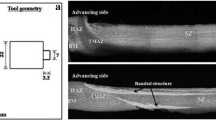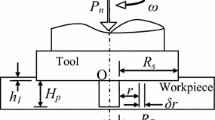Abstract
In this study, the effect of tool shoulder diameter (primary heat generating source) to the plate thickness ratio on tensile and impact toughness properties of friction stir welded high strength low alloy (HSLA) steel was investigated. A naval grade HSLA steel of 5 mm thick plates were welded with tool rotational speed of 600 rpm and welding speed of 30 mm/min using five tungsten based alloy tools having shoulder diameter varying from 20 to 30 mm. Microstructural characteristics of the weld joints were analyzed using optical microscopy along with the evaluation of tensile properties. From this investigation, it was found that the joint fabricated using a tool shoulder diameter of 25 mm (5 times the plate thickness) exhibited superior mechanical properties compared to other joints.







Similar content being viewed by others
References
Fujii H, Cui L, Tsuji N, Maeda M, Nakata K, and Nogi K, Mater Sci Engg A, 429 (2006) 50.
Magudeeswaran G, Balasubramanian V, Reddy G M, and Balasubramaian T S, J Iron Steel Res Int, 15 (2008) 87.
Kang J, Wang C, and Wang G D, Mater Sci Engg A, 527 (2012) 96.
Lambert A, Drillet J, Gourgues A F, Stuel T, and Pineau A, Sci Tech Weld Join, 5 (2000) 173.
Lakshminarayanan A K, and Balasubramanian V, Mater Des, 31 (2010) 4600.
Thompson B, Babu S S, Welding Research, 89 (2010) 261.
Galvao I, Leal R M, and Loureiro A, J Mater Process Technol, 213 (2013)135.
Zhu X K, and Chao Y J, J Mater Process Technol, 146 (2004) 272.
Park S H C, Sato Y S, and Kokawa H, Metal Mater Trans A, 40 (2009) 636.
Gan W, Li Z T, and Khurana S, Sci Technol Weld Join, 12 (2007) 613.
Lienert T J, Stellwag J R, Grimmett B B, and Warke R W, Weld Jour, 89 (2003) 9.
Lakshminarayanan A K, and Balasubramanian V, Metall Mater Inter, 17 (2011) 981.
Malarvizhi S, and Balasubramanian V, Mater Des, 40 (2012) 460.
Ying-qiao Z, Han-qian Z, Jin-fu L I, and Wei-ming L I U, J Iron Steel Res Inter, 16 (2009) 80.
Rajamanickam N, Balusamy V, Magudeeswaran G, and Natarajan K, Mater Des, 30 (2009) 2731.
Lee C H, Bhadeshia H K D H, and Lee H C. Mater Sci Engg A, 360 (2003) 249.
Wan X L, Wei R, and Wu KM, Mater Charac, 61 (2010) 731.
Brown I H, Scrip Mater, 54 (2006) 492.
Momeni A, Arabi H, Rezaei A, Badri H, and Abbasi S M, Mater Sci Engg A, 528 (2011) 2163.
Yamamoto K, Hasegawa T, and Takamura J. ISIJ. Int, 36 (1996) 86.
Ghosh K, and Mishra R S, Scrip Mater, 851 (2010) 85.
Dhua S K, and Sen S K, Mater Sci Engg A, 52 (2011) 6365.
Ghosh A, Das S, Chatterjee S, and Rao P R, Mater Charac, 56 (2006) 65.
Kenyon N, Weld Jour, 1968, 198.
Song K H, Fujii H, and Nakata K. Mater Des, 30 (2009) 3972.
Acknowledgments
The authors are grateful to The Director, Naval Material Research Laboratory (NMRL), Ambernath for financial support through CARS project No: G8/15250/2011 dated 29.02.2012 and providing base material for this investigation. Also the authors are grateful to Dr. A. K. Lakshminarayanan, Associate Professor, SSN College of Engineering, Chennai, India for his valuable suggestions, guidance and discussion to carry out this investigation.
Author information
Authors and Affiliations
Corresponding author
Rights and permissions
About this article
Cite this article
Ragu Nathan, S., Balasubramanian, V., Malarvizhi, S. et al. Effect of Tool Shoulder Diameter on Stir Zone Characteristics of Friction Stir Welded HSLA Steel Joints. Trans Indian Inst Met 69, 1861–1869 (2016). https://doi.org/10.1007/s12666-016-0846-3
Received:
Accepted:
Published:
Issue Date:
DOI: https://doi.org/10.1007/s12666-016-0846-3




